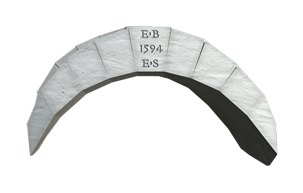Object Descriptions Ground Floor Parlor
Date Stone
The date stone over the door to the Great Hall commemorates the wedding in 1594 of Edmund Spenser and Elizabeth Boyle. Date stones with the initials of the owners of a house were common in England and Ireland and followed the fashion in other countries. They commemorated dates of construction, ownership and other important events in the life of a household, such as marriages.
Eric Klingelhofer argues that this room, the Parlor between the Great Hall and Tower House, was built during Spenser’s time, so such a stone as the one pictured here may have been included in the building’s original construction as testament to the arrival and permanent presence of the newly married couple. Every time Spenser or Elizabeth Boyle would cross the threshold from the more private Parlor to the more public Great Hall, they could keep their mutual faith in mind.

What’s in a name? Spenser was subject to three Elizabeths: his mother, his second wife, and the queen. In his sonnet sequence, Amoretti (1595), he writes two adjacent sonnets (numbers 74-75) that celebrate the name of Elizabeth. In the first, he describes his wife’s “Most happy letters fram’d by skilfull trade” (74.1), and he advertises the coincidence between her name and that of the other two Elizabeths by comparing them to the famous three graces of classical mythology: “Ye three Elizabeths for euer liue,/ that three such graces did vnto me giue” (74.13-14). These graces inspire him to write gracefully about graceful things (see also the vision of four graces given to Spenser’s alter-ego, the character Colin Clout, on Mount Acidale in FQ VI.x).
The second sonnet, #75, is one of Spenser’s best-known poems. It describes how he wrote his love’s “name vpon the strand,/ but came the waues and washed it away” (75.1-2). In order to defeat the ravages of time, he decides to “eternize” her name in his verse instead:
my verse your vertues rare shall eternize,
and in the heuens wryte your glorious name.
Where whenas death shall all the world subdew,
our loue shall liue, and later life renew. (75.11-14)
Spenser’s verse places her name above his head, “in the heavens,” where their love will “renew” itself at the end of time.
Bibliography:
Stella P. Revard, “Graces.” The Spenser Encyclopedia. Ed. A. C. Hamilton (Toronto: U of Toronto P, 1990), 338-9.
Hanneke Ronnes, “Continental traces at Carrick-on-Suir and contemporary Irish castles: a preliminary study of date-and-initial stones” in Thomas Herron and Michael Potterton (eds), Ireland in the Renaissance, c. 1540-1660 (Dublin: Four Courts Press, 2007), 255-73.